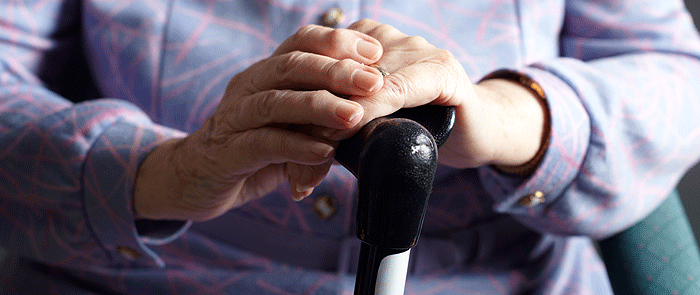
Effective programs and action strategies for elderly falls
It is highly recommended to take into account the state of health and the risk level of the elderly person before proposing a fall prevention program. For the elderly who screen with a high risk of falling, a personalized multifactorial intervention is highly recommended. For the elderly who screen with a moderate risk of falling, a non-personalized multifactorial intervention is recommended. For the elderly who screen with a low (or no) risk of falling, an intervention involving a health or safety promotion program or a primary prevention program is promising. Restricted interventions targeting isolated risk factors may be proposed to the elderly who present just those factors and who screen with a moderate or low risk. Fall prevention programs must focus on risk factors that respond efficaciously to interventions, resulting in decreased falls.
Despite the extent of the problem of falls in the elderly and their sometimes disastrous consequences, there is room for optimism. Indeed, fall prevention programs have demonstrated their effectiveness: the elderly who benefit from these programs have significantly fewer falls than those who do not, the number of hospitalizations is reduced and they experience less loss of functional autonomy (Tinetti, Baker et al., 1994; Campbell, Robertson et al., 1997; Gillespie, Gillespie et al., 2003). The current state of knowledge allows for a relative consensus on the types of interventions that are effective, but is less helpful concerning the optimization of their content and initiation methods to obtain the best possible results. Also, although interventions targeting intrinsic factors have repeatedly demonstrated their effectiveness, those targeting behavioral or environmental factors are currently less well supported in the literature. The recommendations in this Guide arebased on the most recent literature (Feder, Cryer et al., 2000; National Ageing Research Institute, 2000; American Geriatrics Society et al., 2001; SSMG, 2001; Campbell, 2002; Gillespie, Gillespie et al., 2003; Tinetti, 2003). In a public health perspective, the steering committee has also taken into account efficacy and feasibility criteria and has given priority to interventions that focus on the elderly presenting the highest risk of falling and that obtain the best results. This position may occasionally create discrepancies with some conclusions presented in the literature. For example, Gillespie et al (2003) concluded that personalized multifactorial interventions were effective for fall reduction in both the elderly with known risk factors and the elderly with no known risk factors. The steering committee however recommends prioritizing this type of program only in the elderly with a high risk of falls. These interventions are difficult to establish and necessitate the coordination of several healthcare and sociomedical professionals; assessments have demonstrated that they can only be organized for a limited number of elderly each year. Proper identification of the most vulnerable elderly people will allow for the targeting of these interventions on those who need them the most.
The risk level and profile of the elderly person will determine the type of intervention to implement. It is therefore recommended to carry out a simple two step screening before orienting the elderly person toward any particular fall prevention program (American Geriatrics Society et al., 2001). This screening detects a history of falls and evaluates balance and gait. According to the results, the elderly person may be oriented toward a non-specific intervention for overall health, a fall-specific multifactorial intervention or an intervention restricted to specific risk factors.
People with no history of falling in the last year and a negative Timed up & go (TUG) present a low (or no) risk of falling. However, this does not mean that a fall will never happen in the future or that their situation will not evolve. It is therefore recommended to : – regularly reassess fall risks (once per year); – survey and screen for certain important risk factors for which restricted intervention is recommended, such as:
– medication,
– dangers in the home,
– chronic or acute diseases;
– engage these elderly and those close to them in health and safety promotion activities. There are many intrinsic and extrinsic causes of falls. Thus, interventions designed for the elderly population with a low (or no) risk of falls should whenever possible target the elderly person’s overall health. Several strategies can be implemented to promote health and safety to the elderly population. However, data on the impact of these different strategies is currently lacking, concerning both their influence on the overall health of the elderly and their influence on the reduction of accidents and falls.
The elderly and those close to them should be provided with scientifically validated information on fall risk factors and means of prevention, and be informed about health services that can provide counseling and orientation. Certain practices that have a positive effect on general health and fall prevention should be encouraged: – physical exercise; – a balanced diet with only small quantities of alcohol; – correct use of medication; – safety in the home. Numerous communication tools on these themes that target the elderly population specifically have been created and can be used as supports or mediators during consultations. It is recommended however to use a variety of supports and wordings to better allow the elderly to appropriate the message.
To give a few examples, in France, INPES has produced two brochures entitled respectively, “Aménagez votre maison pour éviter les chutes”14 and “Comment garder son équilibre après 60 ans”15. The former provides information on organizing the home to avoid falls and includes personal measures for maintaining balance and quality of life. The latter provides advice for maintaining proper diet and physical exercise. Furthermore, the Cres of Lorraine has produced, “Aînés, acteurs de leur santé”16, an educational tool focused on promoting and improving global health and social activity in the elderly. In French-speaking Switzerland, the OMSV (Office médico-social vaudois) of Lausanne has produced “Vieillir en harmonie, une question d’équilibre: prévenir les chutes”17, which provides advice on balance and fall prevention in daily activities.








